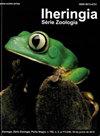Hatchability of gemmules of two Neotropical freshwater sponges (Porifera: Spongillida)
IF 0.5
4区 生物学
Q4 ZOOLOGY
引用次数: 1
Abstract
ABSTRACT Inland waters experience extreme environmental conditions determining the evolution of several adaptive strategies of the fauna to these variable conditions. Freshwater sponges produce resisting bodies called gemmules that contain totipotent cells and specialized spicules (gemmuloscleres). Completely formed gemmules exhibit low metabolic rates and may become dormant during periods of environmental stress. Until now, few species had their hatchability tested against different environmental conditions. The purpose of the present study was to test the capacity of hatching gemmules of two freshwater sponge species (Heteromeyenia cristalina Batista, Volkmer-Ribeiro & Melão, 2007 and Radiospongilla inesi Nicacio & Pinheiro, 2011) from inland waters from different localities. Five assays were tested (A): A1 (water of sponge collection site); A2 (Pirangi River water); A3 (Araraquara Pond water); A4 (mineral water) and A5 (A1 after drying gemmules). For each assay, three replicates with 30 gemmules were used. The gemmules were observed daily during 30 days. Data analysis was performed using ANOVA and a posteriori Tukey test. Results showed that gemmules from both species submitted to A3 have not hatched, probably due to its very high conductivity. There was a significant difference between assays (A1, A2 and A4) and between species (F2, 12 = 77.2; P < 0.001). Comparison between A1 and A5 showed significant differences between both assays and species (F1, 8 = 27.5; P < 0.001). Radiospongilla inesi presented high hatching rate at all assays, while H. cristalina had a high hatching rate only on A1 and A5. Results clearly show that each species has a different capacity of hatching.两种新热带淡水海绵(porfiera:海绵纲)孢子的孵化率
内陆水域经历的极端环境条件决定了动物对这些可变条件的几种适应策略的进化。淡水海绵产生抵抗体,称为小珠,包含全能细胞和专门的针状体(小珠)。完全形成的胚芽表现出较低的代谢率,并可能在环境胁迫期间处于休眠状态。到目前为止,很少有物种在不同的环境条件下测试了它们的孵化能力。本研究的目的是测试来自不同地区内陆水域的两种淡水海绵物种(Heteromeyenia cristalina Batista, Volkmer-Ribeiro & mel, 2007和Radiospongilla inesi Nicacio & Pinheiro, 2011)的孵化能力。5项检测(A): A1(海绵采集部位水分);A2(皮兰吉河水);A3 (Araraquara Pond water);A4(矿泉水)和A5(干粒后的A1)。每次试验使用3个重复,每重复30个微球。在30 d内,每天对雏菊进行观察。数据分析采用方差分析和后验Tukey检验。结果表明,两种递交至A3的卵珠均未孵化,可能是由于A3的电导率非常高。测定法(A1, A2和A4)之间和种之间存在显著差异(F2, 12 = 77.2;P < 0.001)。A1和A5的比较显示两种测定法和物种之间存在显著差异(F1, 8 = 27.5;P < 0.001)。在所有试验中,inesi放射海绵虫的孵化率均较高,而H. cristalina仅在A1和A5上有较高的孵化率。结果清楚地表明,每个物种的孵化能力不同。
本文章由计算机程序翻译,如有差异,请以英文原文为准。
求助全文
约1分钟内获得全文
求助全文
来源期刊

Iheringia Serie Zoologia
生物-动物学
CiteScore
1.00
自引率
0.00%
发文量
12
审稿时长
6-12 weeks
期刊介绍:
The journal Iheringia, Série Zoologia, edited by the “Museu de Ciências Naturais” of the “Fundação Zoobotânica do Rio Grande do Sul”, publishes original research findings in zoology with emphasis on taxonomy, systematics, morphology, natural history, and community or population ecology of species from current Neotropical fauna. Scientific notes will not be accepted for publication. Species lists without a taxonomic approach, or that are not the result of studies on the ecology or natural history of communities will not normally be accepted. The same applies to identification keys of groups of taxa defined by political boundaries. Authors wishing to inquire about the scope of the journal or the suitability of a particular topic are encouraged to contact the Editorial Board prior to submission. Furthermore, articles with a main focus on agronomy, veterinary, zootechny or other areas involving applied zoology will not be accepted.
Its abbreviated title is Iheringia, Sér. Zool., which should be used in bibliographies, footnotes and bibliographical references and strips.
 求助内容:
求助内容: 应助结果提醒方式:
应助结果提醒方式:


